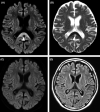Reversible lesion in the splenium of the corpus callosum in a patient with chronic alcoholism
- PMID: 32489763
- PMCID: PMC7260156
- DOI: 10.1002/jgf2.308
Reversible lesion in the splenium of the corpus callosum in a patient with chronic alcoholism
Abstract
Marchiafava-Bignami disease (MBD) is often diagnosed in chronic alcoholics. The disease processes typically involve the corpus callosum and clinically presents with various manifestations on the basis of clinical condition, extent of the splenium of the corpus callosum involvement at brain magnetic resonance imaging (MRI), and prognosis. We report a patient affected by MBD, who presented an isolated reversible splenial lesion at brain MRI and achieved a favorable recovery.
Keywords: Marchiafava‐Bignami disease; chronic alcoholics; reversible lesion; splenium of the corpus callosum.
© 2020 The Authors. Journal of General and Family Medicine published by John Wiley & Sons Australia, Ltd on behalf of Japan Primary Care Association.
Conflict of interest statement
The authors have stated explicitly that there are no conflict of interest in connection with this article.
Figures

References
-
- Ruiz‐Martínez DJ, Martínez Pérez‐Bals A, Ruibal M, Urtasun M, Villanua J, Martí Massó JF. Marchiafava‐Bignami disease with widespread extracallosal lesions and favourable course. Neuroradiology. 1999;41(1):40–3. - PubMed
LinkOut - more resources
Full Text Sources
